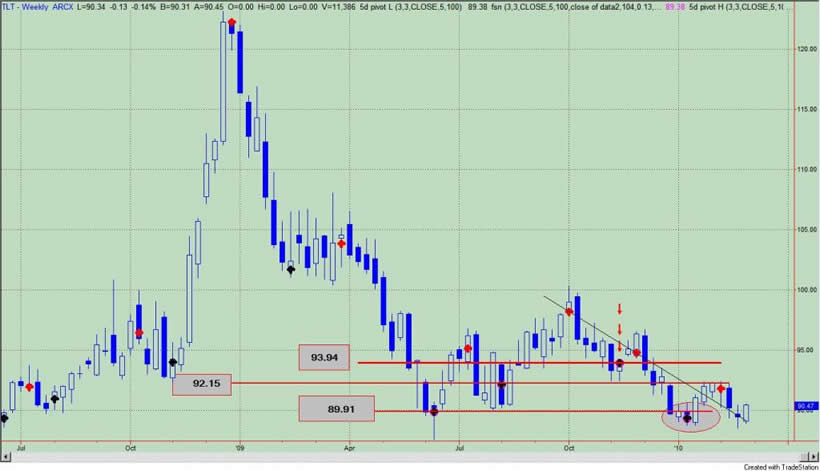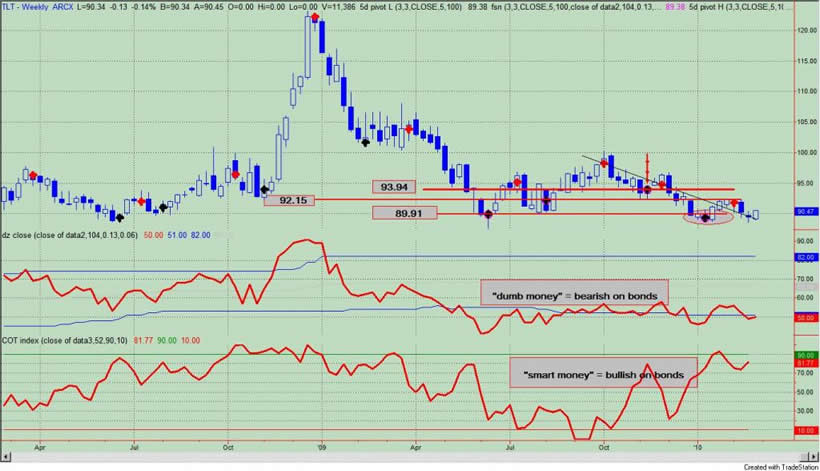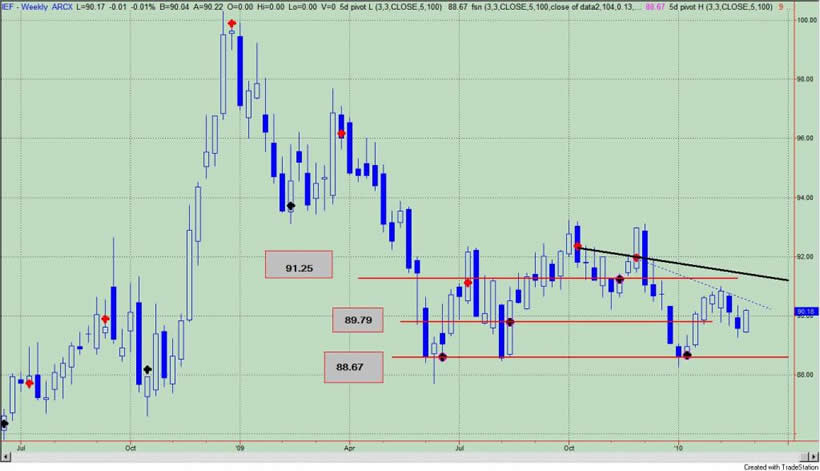U.S. Treasury Bonds, The Correct Play Is To Be Long
Interest-Rates / US Bonds Feb 24, 2010 - 08:29 AM GMTBy: Guy_Lerner
 Over the past many months, I have spent much time on this blog writing about US Treasury bonds. Treasury bonds have become a tale of two diverse stories, and both stories have the potential to be secular or generational in nature.
Over the past many months, I have spent much time on this blog writing about US Treasury bonds. Treasury bonds have become a tale of two diverse stories, and both stories have the potential to be secular or generational in nature.
The case for higher yields or lower Treasury bonds goes something like this: 1) higher yields are expected as the recession ends and the economy picks up steam; 2) higher yields are expected as the Federal Reserve maintains a loose monetary policy beyond all reasonable expectations; 3) higher yields are expected to attract buyers of America's massive debt issuance; 4) higher yields are expected as American debt competes for buyers with other issuers of sovereign debt; 5) Treasury bonds have been in a 20 plus year bull market - isn't it time for this "bubble" to end?
The case for lower yields or higher Treasury bonds goes something like this: 1) the recession and credit contraction is all about deflation - not inflation; 2) Treasury bonds are a safe haven especially with the economy still teetering and the stock market essentially flat since November; 3) for investors, the secular winds of capital preservation are beginning to take hold - the mantra is a return of my principal as opposed to a return on my principal; 4) for American households Treasury bonds are an under represented asset class, but after two stock market crashes and as they near retirement age, investors are pouring money into bond funds at an unprecedented pace and in effect ignoring equities.
As mentioned above, the story of Treasury bonds has become the story of two very plausible outcomes and each outcome could be generational in nature. It should be apparent that many market heavyweights are aligned on both sides of the fence. Marc Faber and Nassim Taleb are calling for higher yields - it's the no brainer trade of the century. David Rosenberg and Hugh Hendry are for higher Treasury bond prices. The WealthTrack video presented the other day made this apparent.
Now we have an excellent article "Explaining the Secular Shift Towards Treasury Bonds". This is courtesy of Babak over at the Traders Narrative blog. The article essentially makes the case that it is the demand side of the equation that has become important in the Treasury market, and as Babak points out, "fund flows into fixed incomes have been positive at a rate that is almost beyond belief". The American household is deleveraging, and fiscal prudence is back in style. This is the secular shift towards income preservation.
As always, the question is how to play this? As explained recently, I have spent a lot of time writing about Treasury bonds and I have very little to show for my efforts. Treasury bonds have done nothing and in fact, I have taken my money off the table as I was long the the i-Share Lehman 7-10 Year Treasury Bond Fund (symbol: IEF), but with a close this past week below key support at 89.79, I moved to the sidelines. But despite this modest setback, I still believe the correct play is to be long Treasury bonds. To understand why, let me present a weekly chart of the i-Shares Lehman 20+ Year Treasury Bond Fund (symbol: TLT). See figure 1.
Figure 1. TLT/ weekly

The black and pink pivot points are our key pivot points and their values are labeled. These tend to be areas of buying and selling or support and resistance. Now if this was a chart of the equity market I would be buying hand over fist. Why? Look at the last key pivot point to the right of the chart (inside the gray oval). That level is support and price has yet to close below that level on a weekly closing basis. This pivot is 89.38.
But how do I know if that pivot will be the ultimate low? How do I know that it won't end up being like the key pivot point at 93.94 (down red arrows)? I don't know, but I do know that the most immediate key pivot point at 89.38 is support albeit it is support within a down trend. But this is a test of that support (i.e., double bottom), and there is a high likelihood of a reversal. Or to put it another way, the continuation of the down trend will only be confirmed on a weekly close below the key pivot point at 89.38.
But there is more. See figure 2 a weekly chart of the TLT. I have added two indicators to our chart in figure 1. In the middle panel is the Bullish Consensus from MarketVane. This looks at the number of advisers who are bullish on bonds, and as we can see from the indicator, advisers are very bearish on bonds and they are so to an extreme degree. The indicator in the lower panel is from the commitment of traders data and it represents the commercial or smart money or deep pocket trader. These folks are very bullish on bonds.
Figure 2. TLT/ weekly

So you say, "This is a no brainer. The "smart money" is bullish and the "dumb money" is bearish. I am betting with the "smart money"." Most of the time that is the correct thing to do, but there are always instances (across all asset classes) where we can point to the "smart money" or "dumb money" being wrong. The question is knowing when these investors are wrong. For example, think about the equity rally over the past year. We would have to say the "dumb money" was right and the "smart money" was wrong, and within that context we had our "moonshot" in equities starting sometime in July, 2009.
So the question becomes: when will we know that the "smart money" will be wrong and the "dumb money" will be right? The answer: a weekly close below the most immediate key pivot point at 89.38.
Let me summarize. Treasury bonds are in a downtrend. The key pivot point at 89.38 should serve as support, and one should be buying at this level despite the downtrend. One should be betting with the "smart money" and against the "dumb money". This is the correct way to play Treasury bonds. Go with the "smart money", not the "dumb money" and buy at support. If we are wrong, that's ok. We know when that will be, and then we can say that "this time is different". Of note, a weekly close over the 92.15 level would confirm a new uptrend.
For completeness sake, I have included a weekly chart of IEF. The important pivot point is at 88.67.
Figure 3. IEF/ weekly

By Guy Lerner
http://thetechnicaltakedotcom.blogspot.com/
Guy M. Lerner, MD is the founder of ARL Advisers, LLC and managing partner of ARL Investment Partners, L.P. Dr. Lerner utilizes a research driven approach to determine those factors which lead to sustainable moves in the markets. He has developed many proprietary tools and trading models in his quest to outperform. Over the past four years, Lerner has shared his innovative approach with the readers of RealMoney.com and TheStreet.com as a featured columnist. He has been a regular guest on the Money Man Radio Show, DEX-TV, routinely published in the some of the most widely-read financial publications and has been a marquee speaker at financial seminars around the world.
© 2010 Copyright Guy Lerner - All Rights Reserved
Disclaimer: The above is a matter of opinion provided for general information purposes only and is not intended as investment advice. Information and analysis above are derived from sources and utilising methods believed to be reliable, but we cannot accept responsibility for any losses you may incur as a result of this analysis. Individuals should consult with their personal financial advisors.
Guy Lerner Archive |
© 2005-2022 http://www.MarketOracle.co.uk - The Market Oracle is a FREE Daily Financial Markets Analysis & Forecasting online publication.



